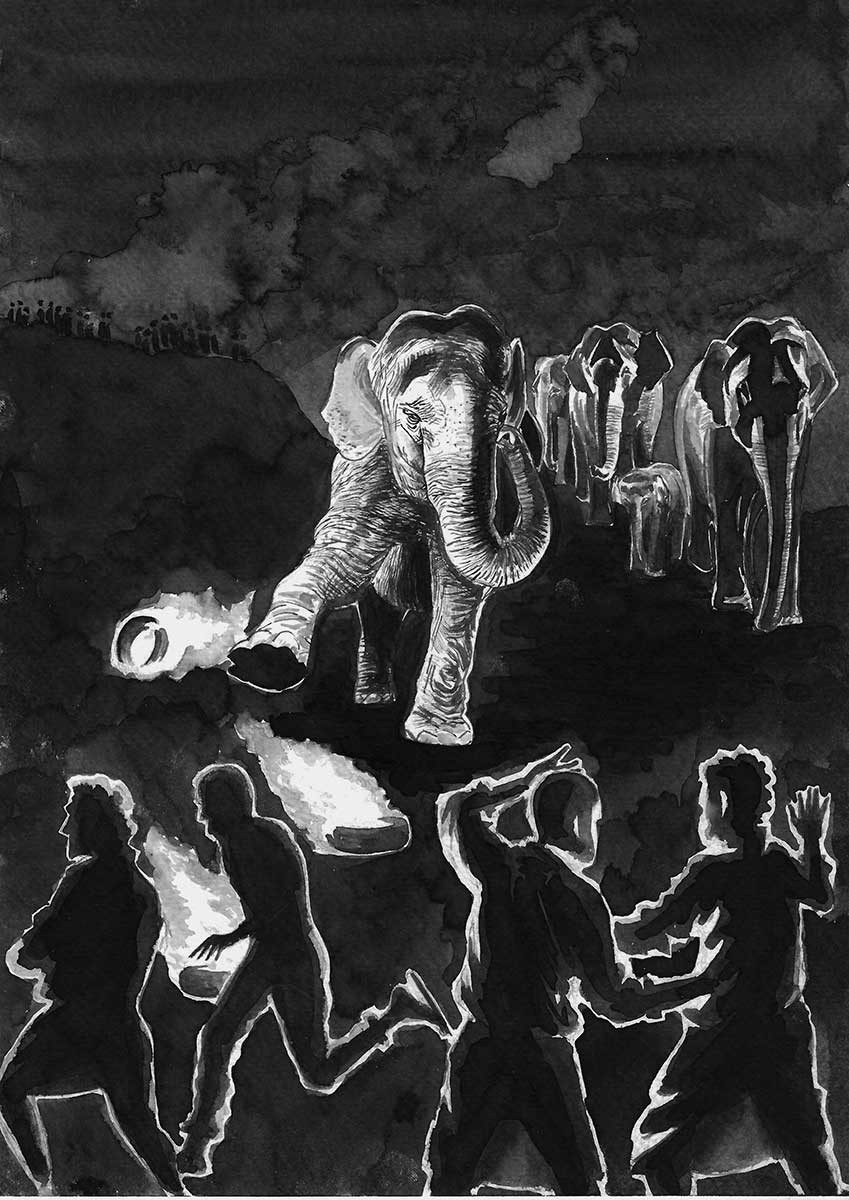‘Twenty-five years is but a blip in historical or, for that matter, ecological time. But it is a landmark in human lifetime’, writes the eminent environmental historian Mahesh Rangarajan in his foreword for At the Feet of Living Things—a collection of essays celebrating a quarter-century of dedicated conservation practice by the Nature Conservation Foundation (NCF). Written by the many members of NCF, a wildlife conservation and research organisation based out of Mysore, the anthology is packed with stirring, ruminative tales of the highs and lows of science-based conservation in India.
At the Feet of Living Things: Twenty-five Years of Wildlife Research and Conservation in India, edited by Aparajita Datta, Rohan Arthur and T.R. Shankar Raman, takes you to the vast corners of the madly diverse landscape that is India, home to some of the most extraordinary flora and fauna on the planet and a human population of 1.4 billion (soon to be the most populous country on the planet)!
Conservation in India is challenging to say the least, as is established in the chapter Contested Terrain, penned by Aparijita Datta, based on her experiences in the Namdapha National Park and Tiger Reserve of Arunachal Pradesh. The displacement of the Lisu tribe to create an inviolate space for tigers within the northernmost rainforest in the world is a prime example of India’s long history of deep-rooted park-people conflict. The dispute over land remains unfinished, with the establishment continuing to view the tribal community as encroachers and their activities within the park as illegal. Datta writes from a place of deep honesty as she ponders the reasons for NCF’s failure to address the issue despite its dedicated efforts that spanned nearly a decade. She acknowledges the flaws in their approach, but ultimately, the history of deep-rooted animosity and scepticism between the parties involved proved insoluble. Conservation approaches need to be fair, equitable and morally defensible, concludes Datta.
The book is divided into five sections, each addressing themes at the forefront of conservation in India. The conflict over contested spaces, as discussed by Datta, falls under ‘Parks and People’, followed by ‘Among Wild Species’, where scientists and researchers portray their personal and intellectual journeys in understanding a key species and striving to protect it. In the chapter A Snow Leopard Dies Again, Charudutt Mishra speaks of a Snow Leopard death he witnessed back in 1997 when the villagers of Kibber took turns flogging the carcass of the long-dead cat. And of another fatality, years later, in 2020, when the Kibber residents gathered to pay their respects and cremated the cat with the offering of the traditional Buddhist scarf (a symbol of purity and compassion reserved for gods and guests of honour). Through these contrasting tales of Snow Leopard deaths from the Spiti Valley, Mishra shows us what is possible when dedicated species conservation programmes involve local communities and other stakeholders in solving a human-wildlife conflict problem.
Both within and outside protected areas in India, people live alongside wildlife species, posing infinite challenges to coexistence, which is the focus of the ‘Living with Wildlife’ section in the book. In one of the stories, Ananda Kumar and his colleagues Ganesh Raghunathan, Sreedhar Vijaykrishnan and Vinod Krishnan chronicle their journey studying human-elephant conflict in Karnataka and Tamil Nadu. Having spent two decades with elephants in human-dominated spaces, the team acknowledges that conservation is 'a journey one should undertake only when prepared for the long haul'. Akin to Datta, they recognise that conservation success is determined by our ability to strike a balance between human well-being and nature conservation.
‘The Fall and Revival of Nature’ is the gloriously sanguine section within the anthology where nature’s confounding capacity for resilience and recovery comes to the fore. ‘Your sense of despair is born out of a hubris most of us harbour as conservationists that nature is a fragile, timorous thing that would crumble altogether but for our brave and noble efforts’, writes Rohan Arthur as he expounds on decades of scientific research on coral reef health in the Lakshadweep islands. Arthur’s story of ocean optimism about a bleached, dying reef and its cyclical degradation and recovery in the face of climate change and overfishing is a reminder of our growing obligation to protect and restore these habitats and to appreciate the natural world’s dogged commitment to resilience.
Though told from multiple perspectives, and with each story, what the author or authors see as central shifts, they remain an earnest attempt at bridging the gap between the idea of conservation and the reality of conservation practice. Some are more engaging, and some more revealing than others. But through these inimitable accounts, what is made crystal clear is the true nature of conservation practice and how it is fraught with obstacles and innumerable failures. Sartaj Ghuman’s fantastic full-page illustrations that showcase a single poignant moment from each chapter are an added bonus and help in immersing yourself in these absorbing tales.
At the Feet of Living Things is a humbling, forthright rumination on the practice of conservation in India, with the rare capacity to restore our curiosity and affection for the natural world.
In the final section of the book, ‘Bringing People and Nature Together’, P. Jeganathan writes in the chapter about his mania for watching birds and listing them on eBird, ‘All we have to do is pass on our obsession so that our bird dreams live on and become a reality. We can change the world, one list at a time’. If anything, NCF has successfully bundled its obsession for the practice of conservation into an assured little title within the Indian literature canon.
At the Feet of Living Things: Twenty-five Years of Wildlife Research and Conservation in India is published by HarperCollins Publishers India, and is available online and at a store near you.




